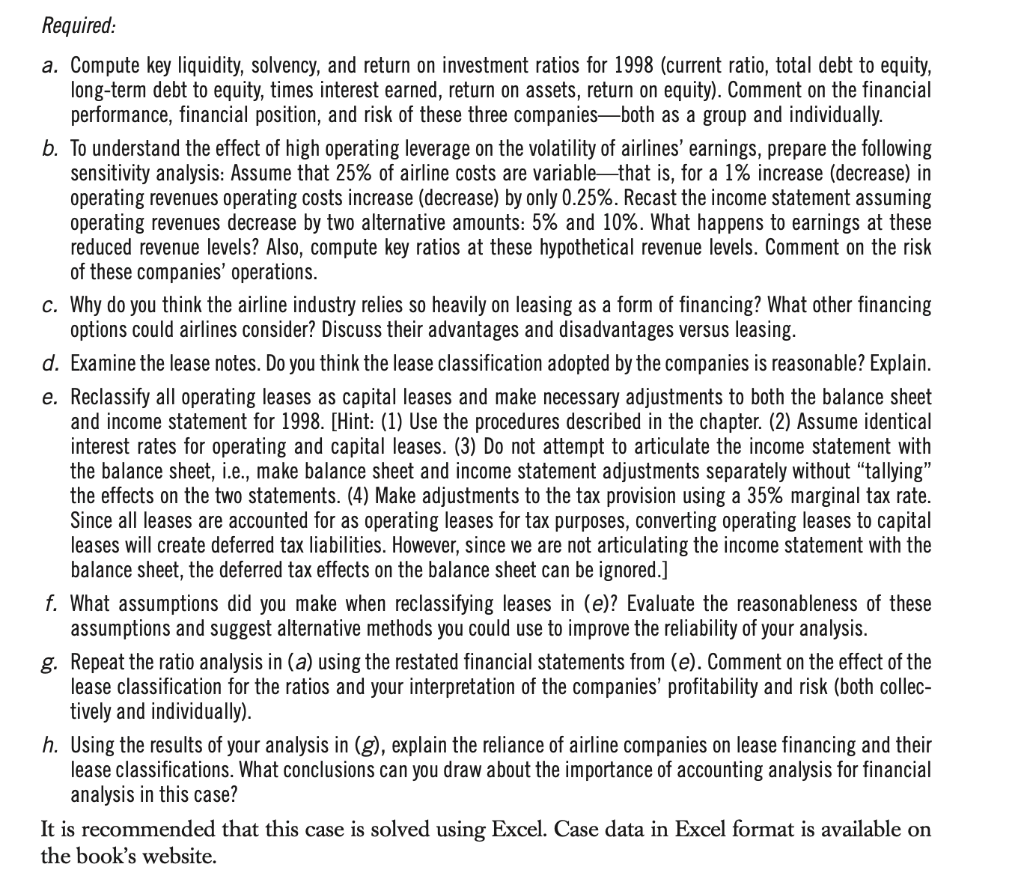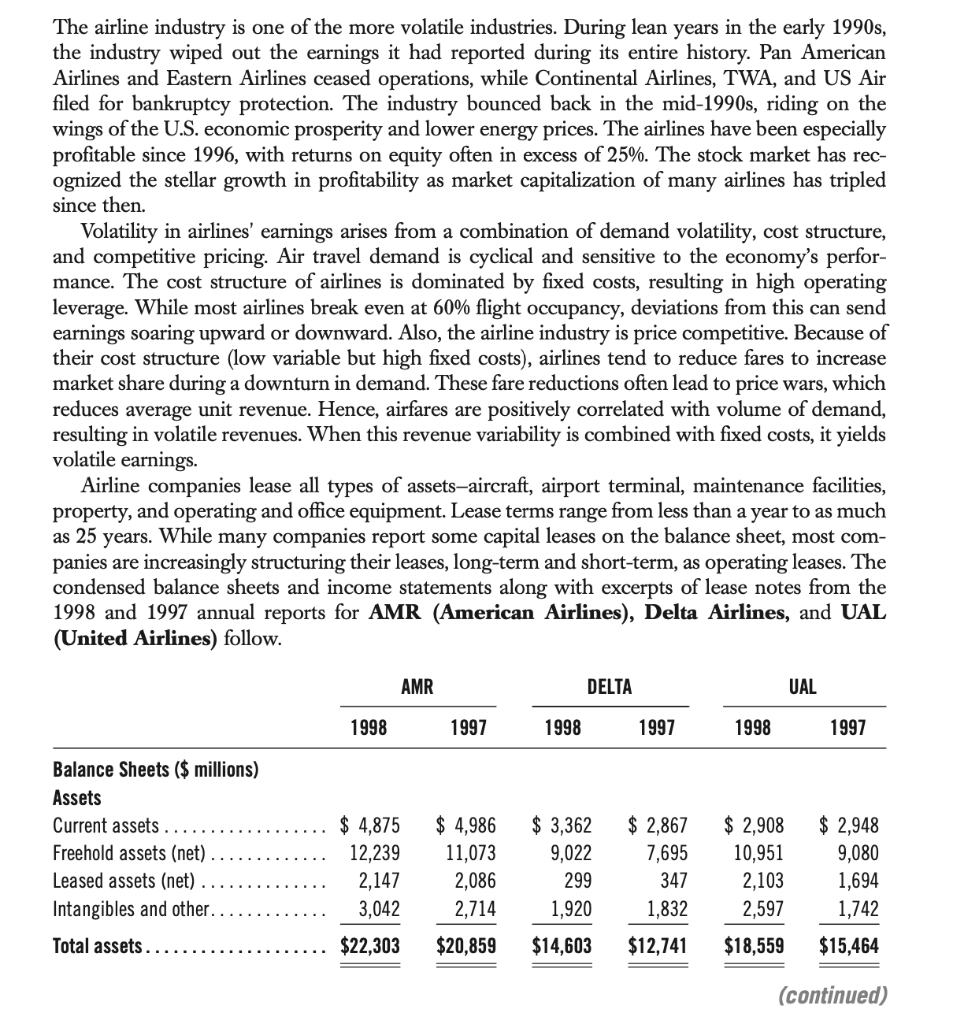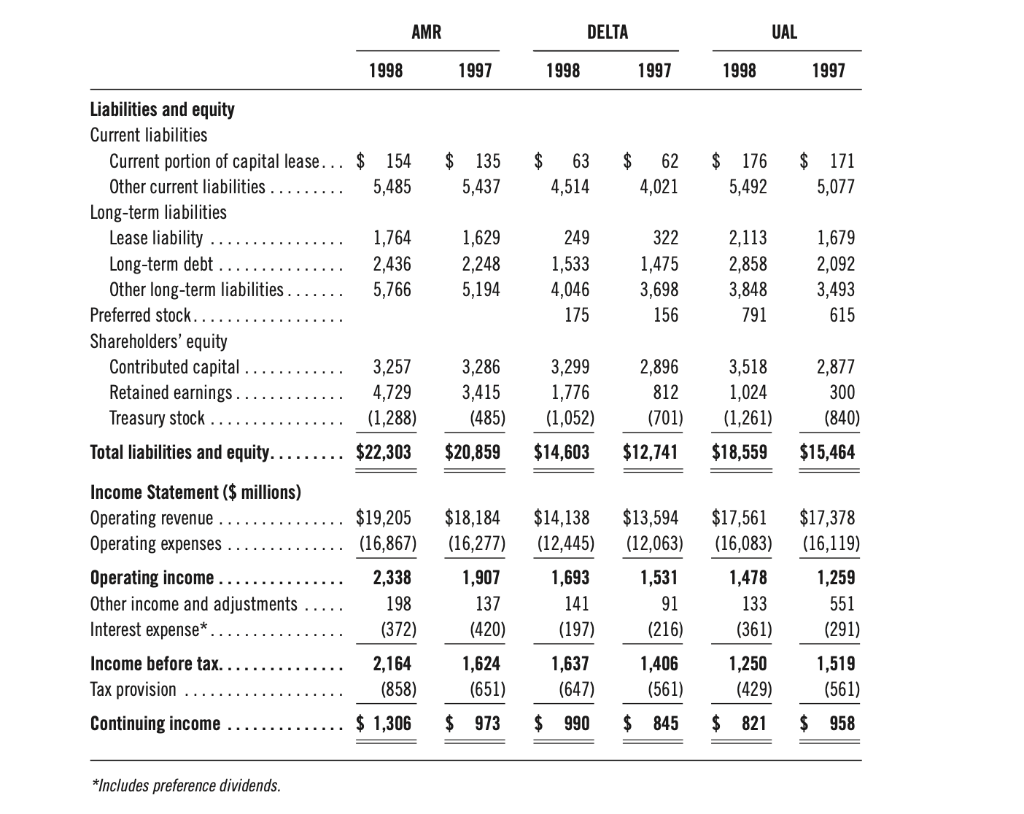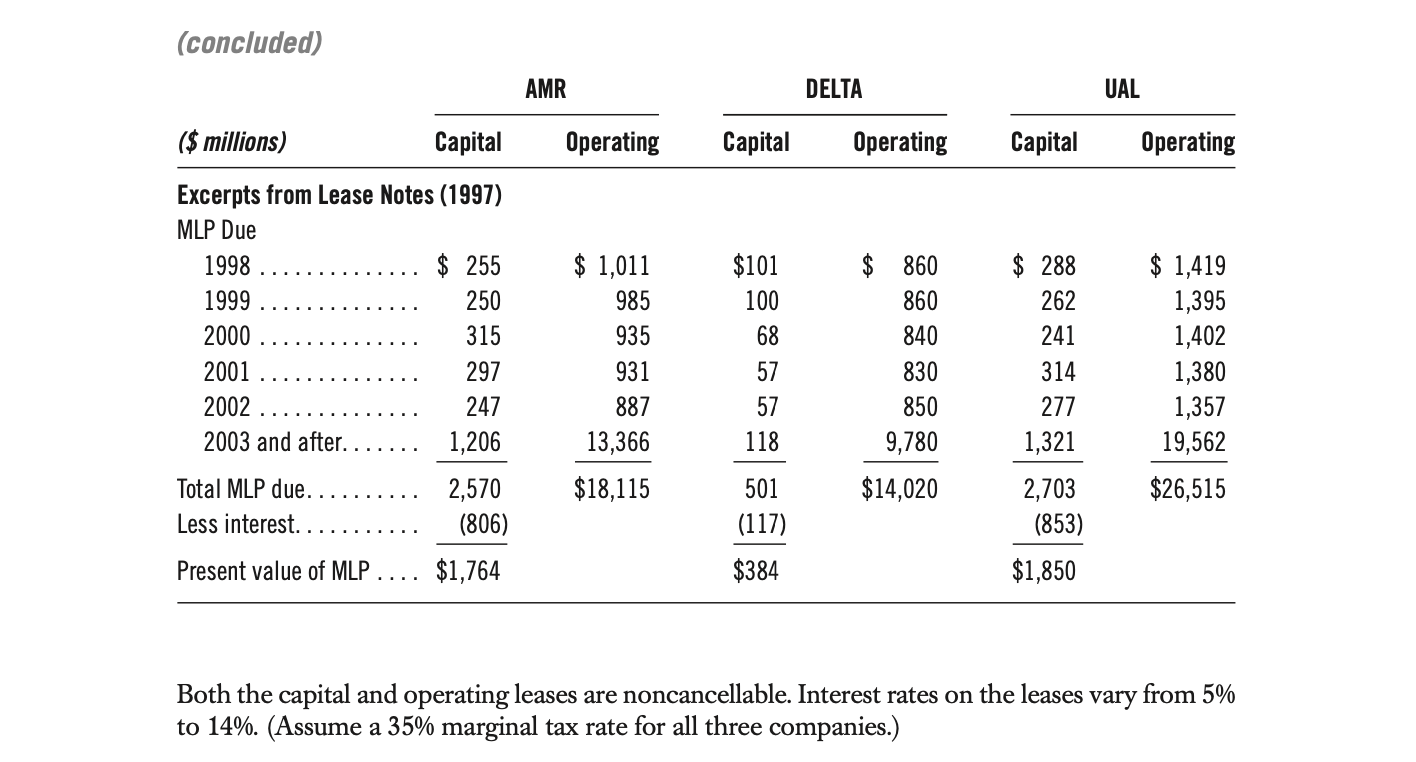Answered step by step
Verified Expert Solution
Question
1 Approved Answer
Hello, can someone help me to answer the question a to h please? Thanks in advance https://www.chegg.com/homework-help/Financial-Statement-Analysis-11th-edition-chapter-3-problem-4C-solution-9780078110962 Required: a. Compute key liquidity, solvency, and return





Hello, can someone help me to answer the question a to h please? Thanks in advance
https://www.chegg.com/homework-help/Financial-Statement-Analysis-11th-edition-chapter-3-problem-4C-solution-9780078110962
Required: a. Compute key liquidity, solvency, and return on investment ratios for 1998 (current ratio, total debt to equity, long-term debt to equity, times interest earned, return on assets, return on equity). Comment on the financial performance, financial position, and risk of these three companiesboth as a group and individually. b. To understand the effect of high operating leverage on the volatility of airlines' earnings, prepare the following sensitivity analysis: Assume that 25% of airline costs are variablethat is, for a 1% increase (decrease) in operating revenues operating costs increase (decrease) by only 0.25%. Recast the income statement assuming operating revenues decrease by two alternative amounts: 5% and 10%. What happens to earnings at these reduced revenue levels? Also, compute key ratios at these hypothetical revenue levels. Comment on the risk of these companies' operations. c. Why do you think the airline industry relies so heavily on leasing as a form of financing? What other financing options could airlines consider? Discuss their advantages and disadvantages versus leasing. d. Examine the lease notes. Do you think the lease classification adopted by the companies is reasonable? Explain. e. Reclassify all operating leases as capital leases and make necessary adjustments to both the balance sheet and income statement for 1998. [Hint: (1) Use the procedures described in the chapter. (2) Assume identical interest rates for operating and capital leases. (3) Do not attempt to articulate the income statement with the balance sheet, i.e., make balance sheet and income statement adjustments separately without tallying the effects on the two statements. (4) Make adjustments to the tax provision using a 35% marginal tax rate. Since all leases are accounted for as operating leases for tax purposes, converting operating leases to capital leases will create deferred tax liabilities. However, since we are not articulating the income statement with the balance sheet, the deferred tax effects on the balance sheet can be ignored.] f. What assumptions did you make when reclassifying leases in (e)? Evaluate the reasonableness these assumptions and suggest alternative methods you could use to improve the reliability of your analysis. g. Repeat the ratio analysis in (a) using the restated financial statements from (e). Comment on the effect of the lease classification for the ratios and your interpretation of the companies' profitability and risk (both collec- tively and individually). h. Using the results of your analysis in (g), explain the reliance of airline companies on lease financing and their lease classifications. What conclusions can you draw about the importance of accounting analysis for financial analysis in this case? It is recommended that this case is solved using Excel. Case data in Excel format is available on the book's website. The airline industry is one of the more volatile industries. During lean years in the early 1990s, the industry wiped out the earnings it had reported during its entire history. Pan American Airlines and Eastern Airlines ceased operations, while Continental Airlines, TWA, and US Air filed for bankruptcy protection. The industry bounced back in the mid-1990s, riding on the wings of the U.S. economic prosperity and lower energy prices. The airlines have been especially profitable since 1996, with returns on equity often in excess of 25%. The stock market has rec- ognized the stellar growth in profitability as market capitalization of many airlines has tripled since then. Volatility in airlines' earnings arises from a combination of demand volatility, cost structure, and competitive pricing. Air travel demand is cyclical and sensitive to the economy's perfor- mance. The cost structure of airlines is dominated by fixed costs, resulting in high operating leverage. While most airlines break even at 60% flight occupancy, deviations from this can send earnings soaring upward or downward. Also, the airline industry is price competitive. Because of their cost structure (low variable but high fixed costs), airlines tend to reduce fares to increase market share during a downturn in demand. These fare reductions often lead to price wars, which a reduces average unit revenue. Hence, airfares are positively correlated with volume of demand, resulting in volatile revenues. When this revenue variability is combined with fixed costs, it yields volatile earnings. Airline companies lease all types of assets-aircraft, airport terminal, maintenance facilities, property, and operating and office equipment. Lease terms range from less than a year to as much as 25 years. While many companies report some capital leases on the balance sheet, most com- panies are increasingly structuring their leases, long-term and short-term, as operating leases. The condensed balance sheets and income statements along with excerpts of lease notes from the 1998 and 1997 annual reports for AMR (American Airlines), Delta Airlines, and UAL (United Airlines) follow. AMR DELTA UAL 1998 1997 1998 1997 1998 1997 Balance Sheets ($ millions) Assets Current assets Freehold assets (net) Leased assets (net) Intangibles and other. Total assets.. $ 2,867 7,695 $ 4,875 12,239 2,147 3,042 $ 4,986 11,073 2,086 2,714 $ 3,362 9,022 299 1,920 $ 2,908 10,951 2,103 2,597 $18,559 $ 2,948 9,080 1,694 1,742 347 1,832 $22,303 $20,859 $14,603 $12,741 $15,464 (continued) AMR DELTA UAL 1998 1997 1998 1997 1998 1997 $ 135 5,437 $ 63 4,514 $ 62 4,021 $ 176 5,492 $ 171 5,077 Liabilities and equity Current liabilities Current portion of capital lease... $ 154 Other current liabilities .. 5,485 Long-term liabilities Lease liability 1,764 Long-term debt 2,436 Other long-term liabilities 5,766 Preferred stock. Shareholders' equity Contributed capital 3,257 Retained earnings 4,729 Treasury stock (1,288) Total liabilities and equity. $22,303 1,629 2,248 5,194 249 1,533 4,046 175 322 1,475 3,698 156 2,113 2,858 3,848 791 1,679 2,092 3,493 615 2,896 2,877 3,286 3,415 (485) 812 3,299 1,776 (1,052) $14,603 3,518 1,024 (1,261) 300 (701) (840) $20,859 $12,741 $18,559 $15,464 $19,205 (16,867) $14,138 (12,445) $13,594 (12,063) $17,561 (16,083) Income Statement ($ millions) Operating revenue Operating expenses Operating income Other income and adjustments Interest expense*. Income before tax. Tax provision Continuing income 2,338 198 $18,184 (16,277) 1,907 137 (420) 1,693 141 (197) 1,531 91 (216) 1,478 133 (361) $17,378 (16,119) 1,259 551 (291) (372) 2,164 (858) 1,624 (651) 1,637 (647) 1,406 (561) 1,250 (429) 1,519 (561) $ 1,306 $ 973 $ 990 $ 845 $ 821 $ 958 *Includes preference dividends. AMR DELTA UAL ($ millions) Capital Operating Capital Operating Capital Operating Excerpts from Lease Notes (1998) MLP Due 1999 $ 273 2000 341 2001 323 2002. 274 2003 191 2004. 1,261 $ 1,012 951 949 904 919 12,480 $100 67 57 57 48 71 $ 950 950 940 960 960 10,360 $ 317 308 399 341 242 1,759 $ 1,320 1,329 1,304 1,274 1,305 17,266 $17,215 $15,120 $23,798 Total MLP due Less interest. 2,663 (745) $1,918 400 (88) $312 3,366 (1,077) $2,289 Present value of MLP. (continued) (concluded) AMR DELTA UAL Capital Operating Capital Operating $101 100 68 ($ millions) Capital Operating Excerpts from Lease Notes (1997) MLP Due 1998 $ 255 $ 1,011 1999 250 985 2000 315 935 2001 297 931 2002 247 887 2003 and after.. 1,206 13,366 Total MLP due. 2,570 $18,115 Less interest. (806) Present value of MLP $1,764 860 860 840 830 850 9,780 $ 288 262 241 314 277 1,321 57 57 118 $ 1,419 1,395 1,402 1,380 1,357 19,562 $26,515 $14,020 501 (117) $384 2,703 (853) $1,850 Both the capital and operating leases are noncancellable. Interest rates on the leases vary from 5% to 14%. (Assume a 35% marginal tax rate for all three companies.) Required: a. Compute key liquidity, solvency, and return on investment ratios for 1998 (current ratio, total debt to equity, long-term debt to equity, times interest earned, return on assets, return on equity). Comment on the financial performance, financial position, and risk of these three companiesboth as a group and individually. b. To understand the effect of high operating leverage on the volatility of airlines' earnings, prepare the following sensitivity analysis: Assume that 25% of airline costs are variablethat is, for a 1% increase (decrease) in operating revenues operating costs increase (decrease) by only 0.25%. Recast the income statement assuming operating revenues decrease by two alternative amounts: 5% and 10%. What happens to earnings at these reduced revenue levels? Also, compute key ratios at these hypothetical revenue levels. Comment on the risk of these companies' operations. c. Why do you think the airline industry relies so heavily on leasing as a form of financing? What other financing options could airlines consider? Discuss their advantages and disadvantages versus leasing. d. Examine the lease notes. Do you think the lease classification adopted by the companies is reasonable? Explain. e. Reclassify all operating leases as capital leases and make necessary adjustments to both the balance sheet and income statement for 1998. [Hint: (1) Use the procedures described in the chapter. (2) Assume identical interest rates for operating and capital leases. (3) Do not attempt to articulate the income statement with the balance sheet, i.e., make balance sheet and income statement adjustments separately without tallying the effects on the two statements. (4) Make adjustments to the tax provision using a 35% marginal tax rate. Since all leases are accounted for as operating leases for tax purposes, converting operating leases to capital leases will create deferred tax liabilities. However, since we are not articulating the income statement with the balance sheet, the deferred tax effects on the balance sheet can be ignored.] f. What assumptions did you make when reclassifying leases in (e)? Evaluate the reasonableness these assumptions and suggest alternative methods you could use to improve the reliability of your analysis. g. Repeat the ratio analysis in (a) using the restated financial statements from (e). Comment on the effect of the lease classification for the ratios and your interpretation of the companies' profitability and risk (both collec- tively and individually). h. Using the results of your analysis in (g), explain the reliance of airline companies on lease financing and their lease classifications. What conclusions can you draw about the importance of accounting analysis for financial analysis in this case? It is recommended that this case is solved using Excel. Case data in Excel format is available on the book's website. The airline industry is one of the more volatile industries. During lean years in the early 1990s, the industry wiped out the earnings it had reported during its entire history. Pan American Airlines and Eastern Airlines ceased operations, while Continental Airlines, TWA, and US Air filed for bankruptcy protection. The industry bounced back in the mid-1990s, riding on the wings of the U.S. economic prosperity and lower energy prices. The airlines have been especially profitable since 1996, with returns on equity often in excess of 25%. The stock market has rec- ognized the stellar growth in profitability as market capitalization of many airlines has tripled since then. Volatility in airlines' earnings arises from a combination of demand volatility, cost structure, and competitive pricing. Air travel demand is cyclical and sensitive to the economy's perfor- mance. The cost structure of airlines is dominated by fixed costs, resulting in high operating leverage. While most airlines break even at 60% flight occupancy, deviations from this can send earnings soaring upward or downward. Also, the airline industry is price competitive. Because of their cost structure (low variable but high fixed costs), airlines tend to reduce fares to increase market share during a downturn in demand. These fare reductions often lead to price wars, which a reduces average unit revenue. Hence, airfares are positively correlated with volume of demand, resulting in volatile revenues. When this revenue variability is combined with fixed costs, it yields volatile earnings. Airline companies lease all types of assets-aircraft, airport terminal, maintenance facilities, property, and operating and office equipment. Lease terms range from less than a year to as much as 25 years. While many companies report some capital leases on the balance sheet, most com- panies are increasingly structuring their leases, long-term and short-term, as operating leases. The condensed balance sheets and income statements along with excerpts of lease notes from the 1998 and 1997 annual reports for AMR (American Airlines), Delta Airlines, and UAL (United Airlines) follow. AMR DELTA UAL 1998 1997 1998 1997 1998 1997 Balance Sheets ($ millions) Assets Current assets Freehold assets (net) Leased assets (net) Intangibles and other. Total assets.. $ 2,867 7,695 $ 4,875 12,239 2,147 3,042 $ 4,986 11,073 2,086 2,714 $ 3,362 9,022 299 1,920 $ 2,908 10,951 2,103 2,597 $18,559 $ 2,948 9,080 1,694 1,742 347 1,832 $22,303 $20,859 $14,603 $12,741 $15,464 (continued) AMR DELTA UAL 1998 1997 1998 1997 1998 1997 $ 135 5,437 $ 63 4,514 $ 62 4,021 $ 176 5,492 $ 171 5,077 Liabilities and equity Current liabilities Current portion of capital lease... $ 154 Other current liabilities .. 5,485 Long-term liabilities Lease liability 1,764 Long-term debt 2,436 Other long-term liabilities 5,766 Preferred stock. Shareholders' equity Contributed capital 3,257 Retained earnings 4,729 Treasury stock (1,288) Total liabilities and equity. $22,303 1,629 2,248 5,194 249 1,533 4,046 175 322 1,475 3,698 156 2,113 2,858 3,848 791 1,679 2,092 3,493 615 2,896 2,877 3,286 3,415 (485) 812 3,299 1,776 (1,052) $14,603 3,518 1,024 (1,261) 300 (701) (840) $20,859 $12,741 $18,559 $15,464 $19,205 (16,867) $14,138 (12,445) $13,594 (12,063) $17,561 (16,083) Income Statement ($ millions) Operating revenue Operating expenses Operating income Other income and adjustments Interest expense*. Income before tax. Tax provision Continuing income 2,338 198 $18,184 (16,277) 1,907 137 (420) 1,693 141 (197) 1,531 91 (216) 1,478 133 (361) $17,378 (16,119) 1,259 551 (291) (372) 2,164 (858) 1,624 (651) 1,637 (647) 1,406 (561) 1,250 (429) 1,519 (561) $ 1,306 $ 973 $ 990 $ 845 $ 821 $ 958 *Includes preference dividends. AMR DELTA UAL ($ millions) Capital Operating Capital Operating Capital Operating Excerpts from Lease Notes (1998) MLP Due 1999 $ 273 2000 341 2001 323 2002. 274 2003 191 2004. 1,261 $ 1,012 951 949 904 919 12,480 $100 67 57 57 48 71 $ 950 950 940 960 960 10,360 $ 317 308 399 341 242 1,759 $ 1,320 1,329 1,304 1,274 1,305 17,266 $17,215 $15,120 $23,798 Total MLP due Less interest. 2,663 (745) $1,918 400 (88) $312 3,366 (1,077) $2,289 Present value of MLP. (continued) (concluded) AMR DELTA UAL Capital Operating Capital Operating $101 100 68 ($ millions) Capital Operating Excerpts from Lease Notes (1997) MLP Due 1998 $ 255 $ 1,011 1999 250 985 2000 315 935 2001 297 931 2002 247 887 2003 and after.. 1,206 13,366 Total MLP due. 2,570 $18,115 Less interest. (806) Present value of MLP $1,764 860 860 840 830 850 9,780 $ 288 262 241 314 277 1,321 57 57 118 $ 1,419 1,395 1,402 1,380 1,357 19,562 $26,515 $14,020 501 (117) $384 2,703 (853) $1,850 Both the capital and operating leases are noncancellable. Interest rates on the leases vary from 5% to 14%. (Assume a 35% marginal tax rate for all three companies.)Step by Step Solution
There are 3 Steps involved in it
Step: 1

Get Instant Access to Expert-Tailored Solutions
See step-by-step solutions with expert insights and AI powered tools for academic success
Step: 2

Step: 3

Ace Your Homework with AI
Get the answers you need in no time with our AI-driven, step-by-step assistance
Get Started


